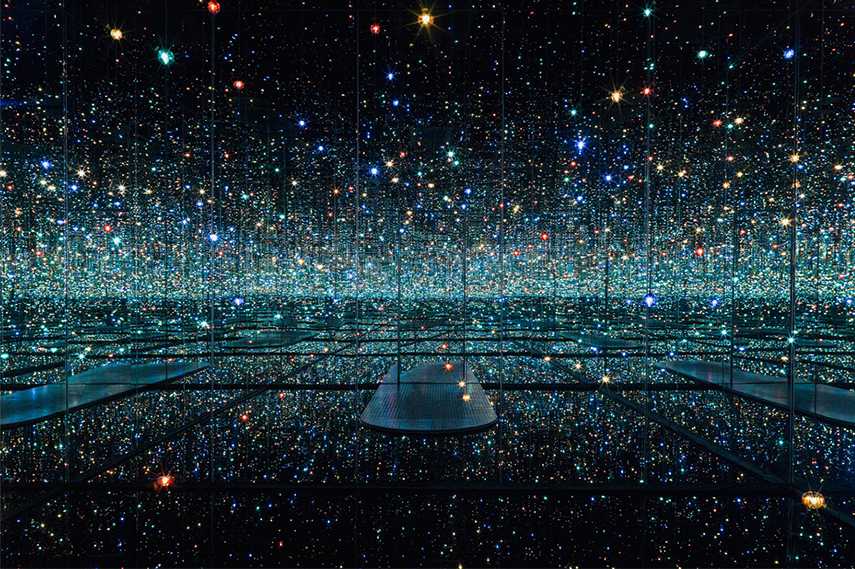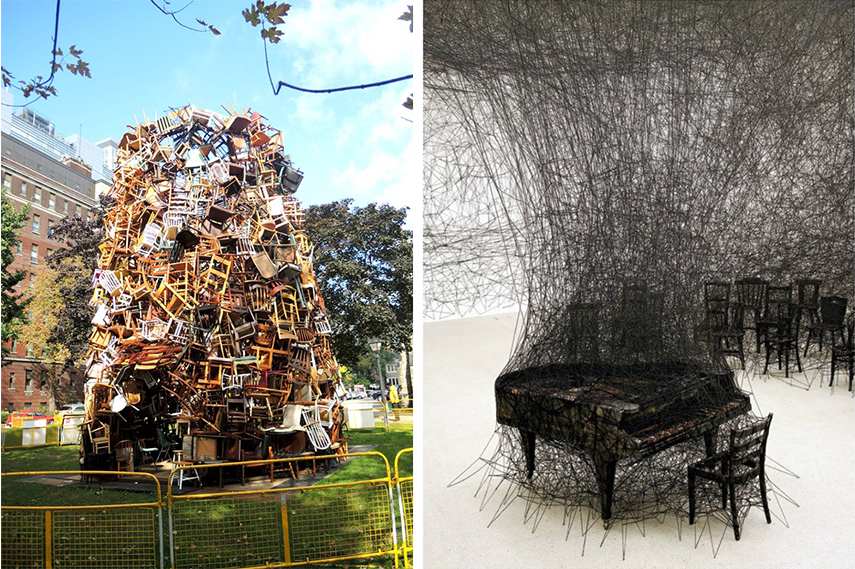A Work of Art That Can Be Entered So That Viewers Are Immersed in an Experience Is Called
In the modern world where so many different art forms have been born, adult, explored and even forgotten over time, well-nigh no other manifestation of art is then impressive and instantly mesmerizing as installation art. When yous walk into a room where the majority of the space around you is really a part of the artwork, you yourself become office of the art. When yous see something that shouldn't quite exist there and stands out in an obvious manner, and yet somehow fits in the environs in a peculiar way, you're probably looking at another piece of art made past installation artists. It offers so much more than a traditional painting, sculpture or any other kind of creativity would. It may appoint yous on multiple levels, activating your senses to experience fine art in a new way; touch, sound, odor besides equally vision are explored to convey the artistry of installations. Often, the focus is centered on the idea and the impact of information technology, rather than the quality of a finished product. Usually, installation art is a purely temporary work of art, but its bear on, message and the notion behind information technology remain forever. Permit us further explore this fascinating, engaging, and bewildering art course embodied in installations that will seduce you and make you stop to think for a second, and possibly fifty-fifty make you question the notions around it, the world and yourself.

Installation Art - Origins and Development
The origins and roots of installation art are often associated with Conceptual art, tracing the steps all the way back to artists like Marcel Duchamp and his innovative approach of presenting his readymades; specifically the controversial urinal piece called Fountain from 1917. Other early influences that are considered to have paved the way for the developing of installation art as such, include the advanced Dada exhibitions, diverse works and assemblage fine art which notably filled unabridged rooms, theories of Spatialism, and fifty-fifty some pieces by John Muzzle. In fact, before it even got the proper noun, the earlier version of this groundbreaking art movement was referred to as the environs, which was started by the American artist Allan Kaprow in 1957. It wasn't until the 1970s that the term Installation began to be employed to draw works which take into account the viewer's entirely sensory experience, or basically fill out an entire room of a gallery, leaving space and time as its only dimensional constants.
Either temporary or permanent, installation artworks are synthetic within exhibiting venues like galleries and museums, or in public or private locations. Installations can include a very broad range of materials used, natural and man-made alike, giving an individual consummate creative freedom over the artwork. With the development of latest technologies, installation art did non stay backside; video, sound, immersive virtual reality, Internet and performance are just some of the media outlets which are oftentimes function of the piece. Site-specific installations are designed to exist and "function" only in the location for which they were created, making them role of the surroundings. Other artworks could be moved and presented in various locations, not depending on their environment. It is this sensory engaging fine art practice that blurs the line between art and life, as Kaprow noted, if we bypass 'art' and take nature itself as a model or betoken of departure, we might be able to devise a different kind of art…out of the sensory stuff of ordinary life.

Sculpture or Installation Artwork?
A logical question of the difference between Sculpture and Installation might boggle some critics, and as much as some installations may resemble traditional arts and crafts-based sculptures, they do not fall under the same category. Installation art finer inverts the principles of sculpture where the piece is designed to be viewed from the outside, experienced as a self-contained system of elements. On the other hand, installation works often include and envelop the spectator in the surroundings of the piece, furthermore, it could be said that installation art is created with the focus on the viewer, where he/she becomes well-nigh the main subject of the artwork, taking into account the spectator's involvement and interaction with the art piece. The ceremonial of the composition falls to the groundwork, bringing the upshot of the viewer'southward spatial and cultural expectation to a focal point. The sensitively arranged piece creates a dialogue with its environment, waiting for the spectator to accept in both the creation and its environs as an overall immersive brandish.

Diversity of Forms, Locations and Effects of Installation Art
Where can installation art exist institute? Literally – anywhere; from galleries, museums and exhibiting spaces, to public spaces such equally playgrounds, pedestrian walkways, streets and building sites. Ordinarily, these artworks really do stand out and catch your attention equally presently as you encounter/hear/feel them. However, sometimes it can be quite difficult to discern whether you're witnessing an artistic installation slice, or simply an unintentional scene from everyday life. Like in Bolzano, Italy, when a group of cleaners misinterpreted an art installation made by Goldschmied & Chiari at the Museion, and thought they needed to become to piece of work and clean upwardly the area from all the ''garbage'' someone left behind. On the other hand, these 10 gripping street fine art installations are surely non to exist taken the wrong way every bit they perplex the passers-by and conspicuously stand out as out of the ordinary. A sub-category of it, chosen interactive installation, essentially involves the audience to human action on the piece of art, thus making an interactive dialogue betwixt the art and the spectator. From web-based installations, gallery-based works, mobile, digital, electronic and all sorts of other structures, the interaction could be based around almost any type of medium. The beauty of installation art lies in its vast range of unlike materials, mediums and environments used to create a notion-challenging artwork. The unique concept of weaving the art piece effectually the viewer, and for the viewer, makes it an effect definitely worth engaging in.

What Happens to the Installations afterwards the Testify?
More and more is the field of art today equated and measured by the status on the art marketplace, notwithstanding, there is art which is made and exhibited not for those who wish to be fine art collectors or buyers. Logically, these people found the bulk of the art public, a typical visitor of an exhibition does non look at the piece on display equally a article. Afterwards all, when it comes to performance-based, conceptual, installation, or otherwise ephemeral work of fine art, how do yous turn a transient experience into something that tin can be bought and sold? Naturally, two-thirds of all the artworks sold are paintings, and installation, video, operation, cartoon, time-based or conceptual practices account for less than 1% of the market. Nevertheless, not all of the artists who work in the "unsellable" field of installation art dream of making a living from their ephemeral creations. In fact, many of them intentionally wish to thwart the institution of the market, positioning their artwork every bit a critique of the system. For instance, Yves Klein's The Void was sold to collectors for a gold coin. After procuring the receipt of the transaction to the collector, the artistic promptly threw the gold coin into the Seine. The said receipts are fifty-fifty now on display in glass vitrines at the Pompidou Eye in Paris. This raises the question of how the scheme of carefully executed certificates, high-production value photographs, express edition prints and other ephemera tin can actually play the role of the collectable aspect for the individuals and cultural institutions. It is argued that these items only produce the appearance of limited admission through claims of uniqueness or actuality. This discussion somewhen leads to the soapbox of intellectual property and how it is sold and bought.
Meet more works by Yves Klein on our marketplace!
Essentially, installation art is quite problematic and hard to sell, naturally due to its size, shape and form, which pose a complicated chore for any collector. And then, what exactly happens with the installation pieces after they're non sold or housed in whatever gallery or museum? Most of the fourth dimension, afterwards the display ends, the artwork is disassembled and either returned to the artist'due south studio or placed in storage. On the other hand, some artists such every bit Terence Koh, tend to disparate elements from the installation and sell them as individual artworks which are divided and titled by the artist himself. Some of the unique pieces finish up as backdrops for films or become setups to be photographed. Of grade, non all authors and curators consider selling components of an artwork as an option even. Some installations wouldn't role without every role being together, and many critics say chopping up an artwork into pieces for sale is like making a buffet and a travesty out of a piece of art. (Speaking of which, have a wait at what Cards Against Humanity had in mind when it comes to chopping artworks!). Other artists are considering the practical side of it, taking in business relationship the storage, shipping and mobility of the artwork itself, and so for instance, Judith Hoffman started making "collapsible" works which are more hands moved, and switched from using metal and wood to lighter materials like paper, because it was simply easier to carry, and as the artist stated herself, they are much easier to sell and she wants to make coin, later all. So, whether or non the artists will yield to the market, or the market volition get more ephemeral art-friendly, installation art remains to suspension the boundaries of our perception in every possible fashion. It is there to be witnessed and experienced fully, to immerse the viewer and captivate the audience, challenging the notions of art and expression.

Editors' Tip: Gimmicky Installation Art
In a bid to encounter the demand of times, the Modern Installation Art book assembles the topmost installation artworks from across the globe, including detailed pictures as well equally graphic blueprint patterns and paw-drawn sketches. Viewed as a genre of newly emerging art, installation art has endowed artists with ultimate creative freedom thank you to its distinctive characters of creation materials and structures. In recent years, installation works have been often showcased in a wealth of diverse exhibitions, condign an indispensably vital office in the history of fine art. Don't miss this unique publication, as information technology is indeed i of the most comprehensive ones on the subject.
Featured images: Henrique Oliveira - Tangled Constructions; Toshiko Horiuchi MacAdam - Harmonic Motion; William Forsythe - White Bouncy Castle; Audiovisual installation titled Daydream V.2 created by Nonotak Studio; Chiharu Shiota - Over The Continents; Ernesto Neto - artwork; Filthy Lurker - Octopied Edifice in French republic. All images used for illustrative purposes just
Source: https://www.widewalls.ch/magazine/installation-art
0 Response to "A Work of Art That Can Be Entered So That Viewers Are Immersed in an Experience Is Called"
Postar um comentário